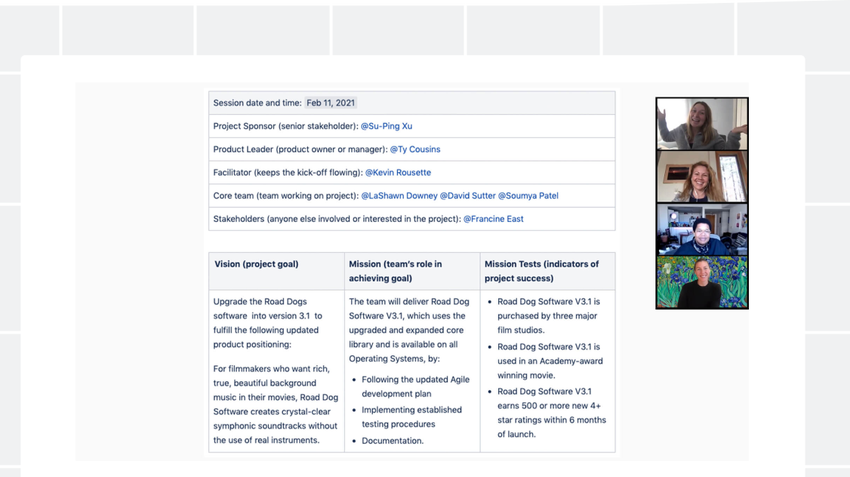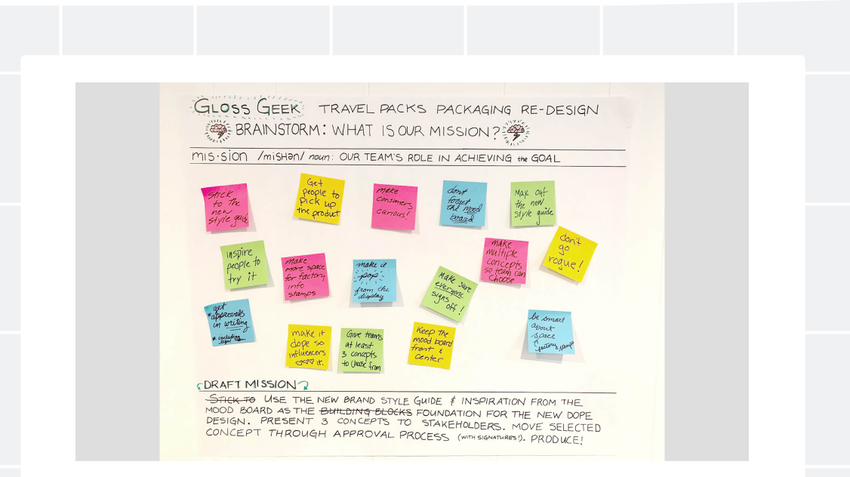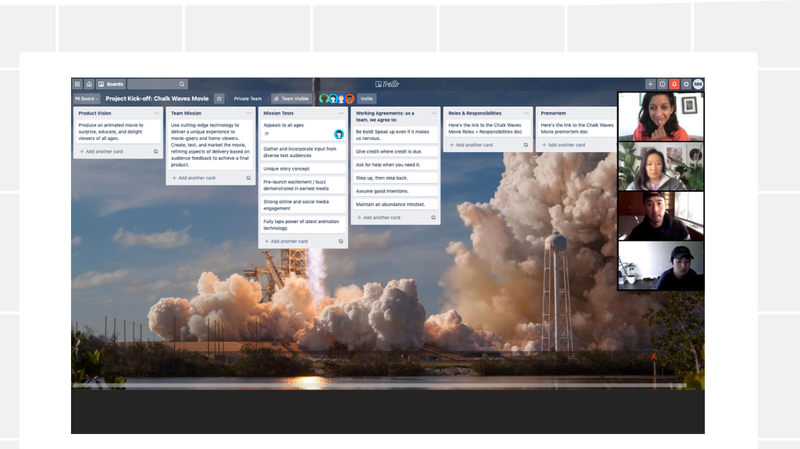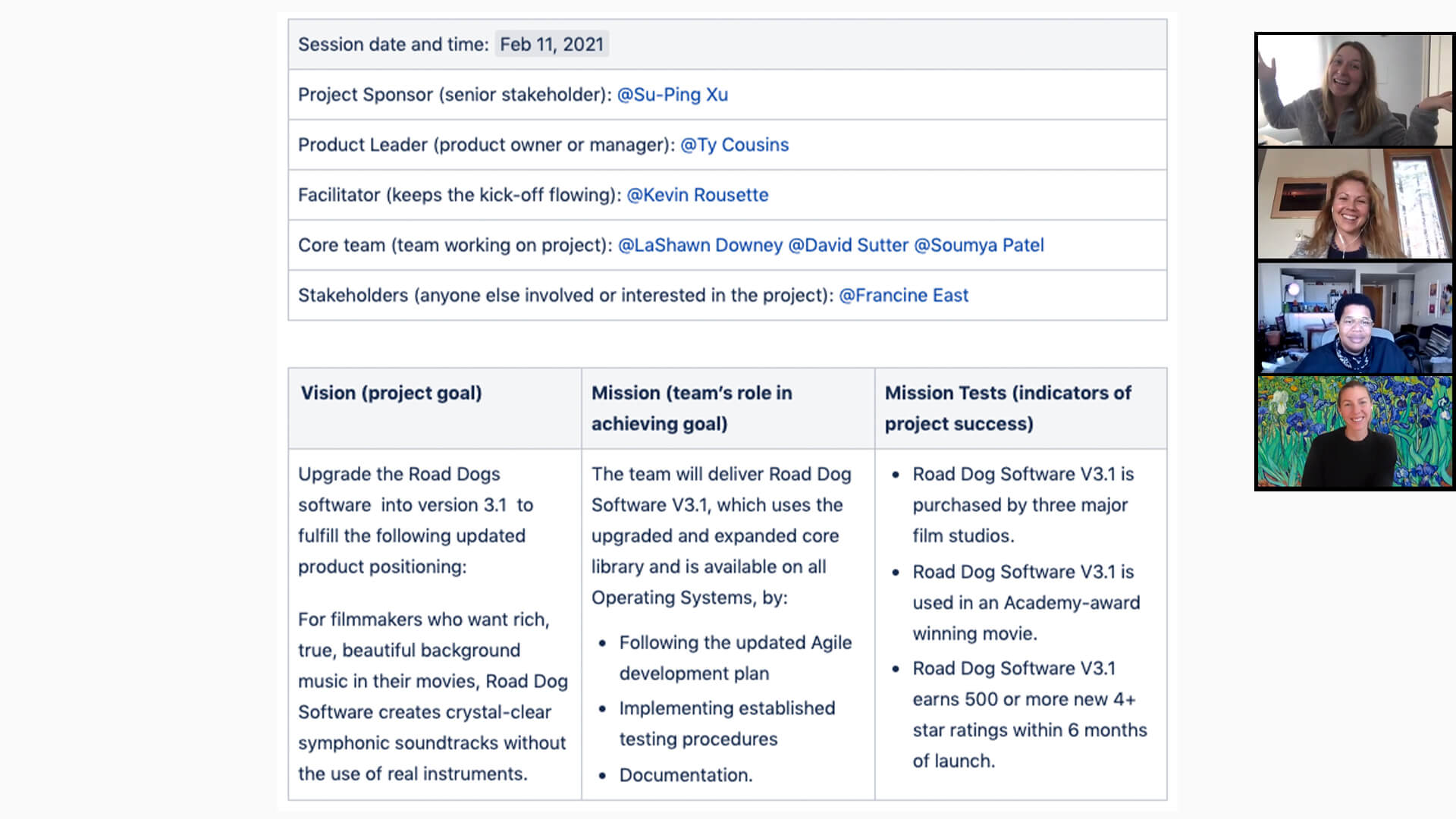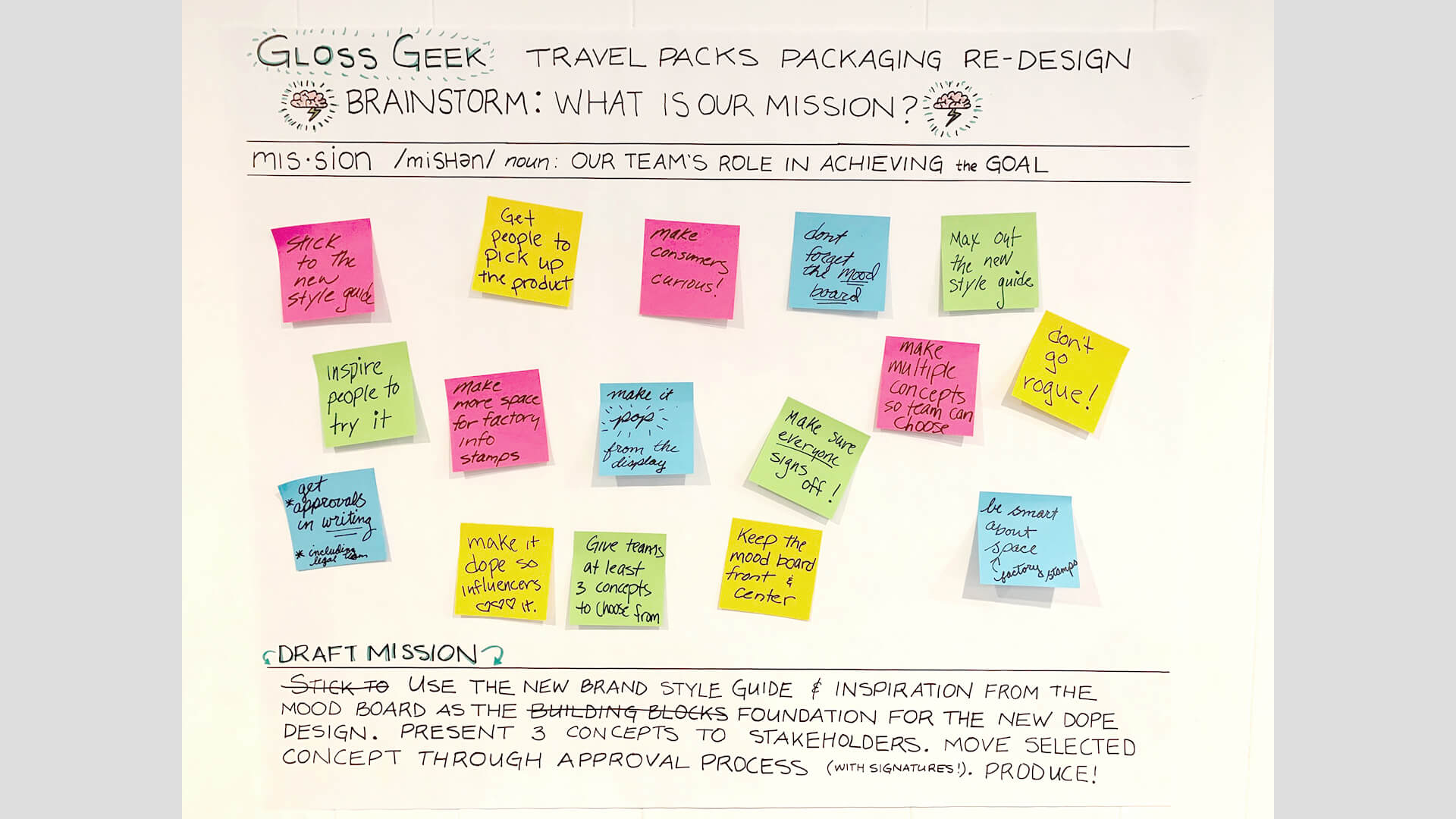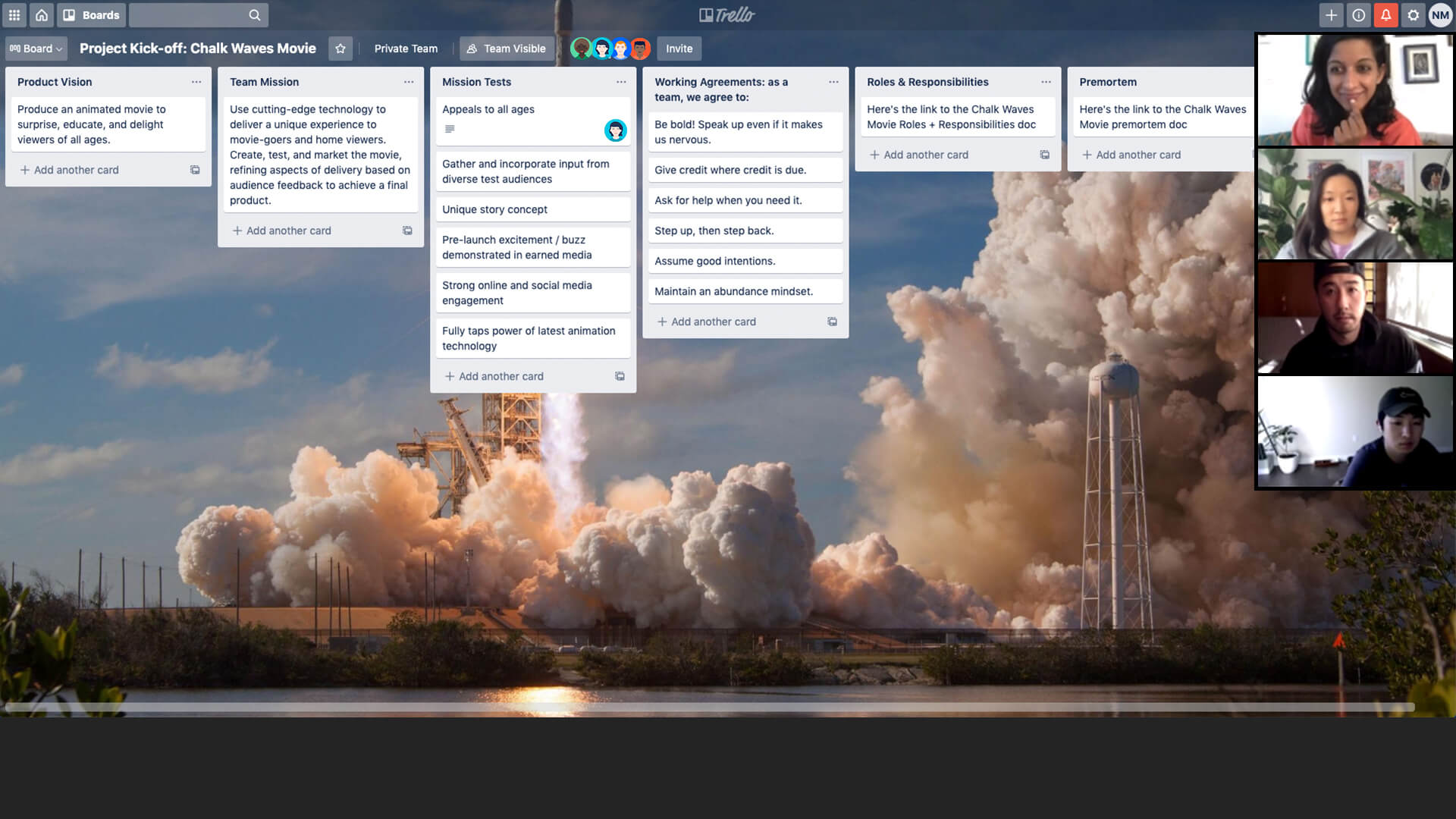Project Kickoff
A little planning can lead to a lot more success. Gather your project team for a kickoff to align on the project's purpose and how you’ll work together to achieve it.
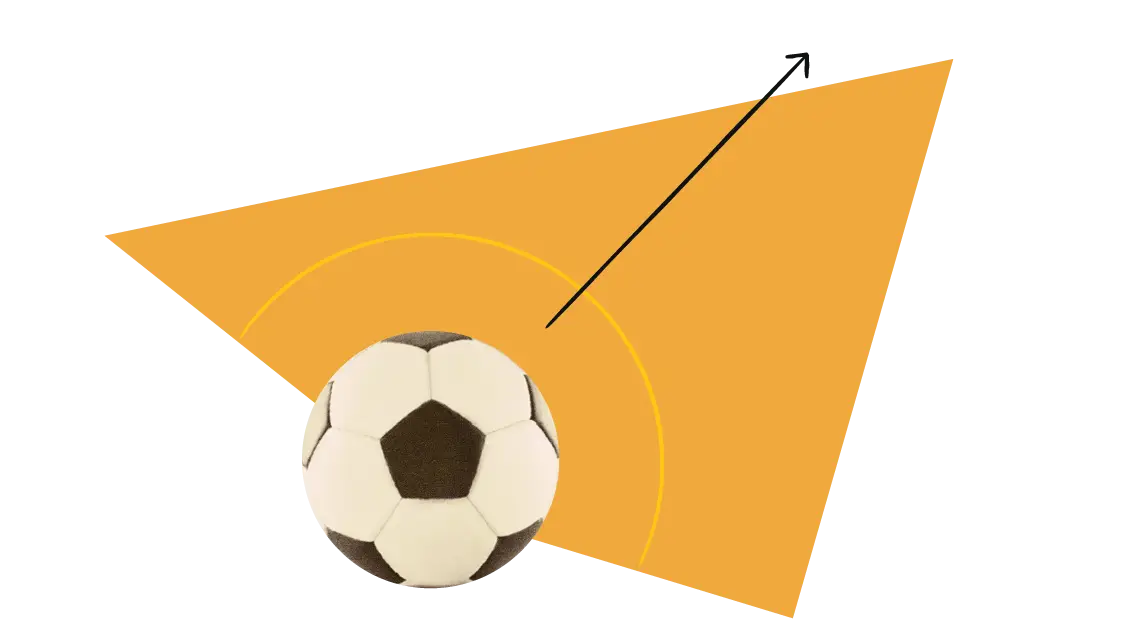
PREP TIME
30m
Run TIME
90m
Persons
3-14
5-second summary
- Determine project team members and their roles.
- Define the project vision, mission, and mission tests.
- Get your team aligned on the purpose of the project and how you’ll work together to achieve it.
WHAT YOU WILL NEED
- Video conferencing with screen sharing or meeting space.
- Digital collaboration tool (see templates).
- Optional: physical whiteboard, markers, timer, and sticky notes.
PLAY resources
How to plan a project kickoff
Bring your team together at the beginning of a project to agree on what success looks like and start creating a plan to achieve it.
What is a project kickoff?
A project kickoff meeting is the first meeting with the project team and the project client (when applicable). This meeting establishes the project’s purpose, roles, responsibilities, and success markers.
Why run the Project Kickoff Play?
Starting a project without a kickoff meeting is like starting a road trip without a map or directions. You’ll probably waste a lot of time, money, and energy getting to your destination – if you make it at all. Running the Project Kickoff Play sets the course for smooth collaboration and success.
When should you do a project kickoff meeting?
The project kickoff typically takes place after the statement of work or project poster has been finalized and everyone is ready to get started.
The benefits of project kickoff meetings
The kickoff meeting is an opportunity to align your team around the project's “who, what, where, when, why, and how.”
Research shows there are proven benefits to gaining consensus around several of the topics discussed during a project kickoff:
- Clarifying roles
Clearly understanding roles and responsibilities can drive better outcomes by improving communication, coordination, trust, and team member satisfaction. - Set the stage by building psychological safety
Teams with established norms that encourage collaboration and open dialogue perform better. - Vision
When employees understand the vision (or why their work matters and how it affects others), their job performance, persistence, and productivity increase. - Clear success criteria, or mission tests
Unclear requirements lead to costly rework. Outlining what success looks like and fixing things early often reduces confusion and costs later.
1. Identify project collaborators
Est. time: 10 MIN
Before running this Play, identify your project sponsor, project leader, facilitator, core team, and stakeholders. (One team member might hold multiple roles.)
- Project sponsor (or executive sponsor): The most senior stakeholder who has the most to gain or lose from your project’s delivery
- Project leader: Sets the vision on what the team is delivering and why
- Facilitator: Responsible for keeping the kickoff meeting flowing and focused
- Core team: The people who do the project work
- Stakeholders: Anyone with insights, information, feedback, or a vested interest in the project’s outcome
tip: TAILOR TO YOUR TEAM
The Project Kickoff Play is flexible and can easily be adapted. Use the other Plays under “Variations” below as inspiration to customize the agenda for your team.
Not everyone needs to attend all parts of the kickoff. Keep any variations you add to just the core team.
2. Define the destination
Est. time: 20 MIN
Bring together the project sponsor, leader, and facilitator to draft a project vision, mission, and mission tests in a collaborative document, such as a Confluence page, whiteboard, or Trello board. The rest of the project team will participate in a 5-minute silent pre-read of the project poster.
Next, the team will revise these elements during the kickoff meeting:
- Vision: Your “why,” or the impact your team will make when the project is completed. Why are you pursuing this project?
- Mission: Your “what” and “how.” What are you trying to do? How will you achieve your vision?
- Mission tests: Your “when.” What will it look like when this project is successful? These tests indicate if your mission is on track and create a shared definition of “done.”
3. A word from our sponsor
Est. time: 5 min
Ask your project sponsor to open the session by welcoming attendees and sharing a quick overview of the project and its relationship to the organization. If your sponsor isn’t available to join the session, you can ask them to record a quick video, like a Loom, ahead of time to share with the group.
4. Set the stage
Est. time: 5 min
At the beginning of the project kickoff meeting, share an overview of the agenda, along with some mutual agreements to keep the conversation productive:
- Collaboration: Let’s work together to setup this project for success.
- Good enough: Let’s aim for progress, not perfection. Gather enough information to create a shared understanding, then continue refining it in the future.
- Possibility: Let’s suspend judgment about what has been, and keep an open mind about what could be.
5. Break the ice
Est. time: 10 min
Start with a short icebreaker to get everyone focused and in the right mindset.
If the group doesn’t already know each other, have each person introduce themselves, explain their role in the project, and answer one icebreaker question. (See the Icebreakers Play for inspiration.)
If the group is already familiar, skip straight to the icebreaker.
6. Refine the vision, mission, and mission tests
Est. time: 60 min
This is the most important aspect of the project kickoff: rallying the team around a shared purpose that can inspire and guide them.
Begin by sharing the initial vision, mission, and mission tests created before the kickoff. Then, break attendees into three groups: one for vision, one for mission, and one for mission tests.
Give each group 20 minutes to refine the initial statements. Next, bring the group back together to present and discuss their revised statements.
Make any agreed-upon changes, then vote to formally accept them for the project. You can (and should) refine these elements later in the project as you uncover new information.
tip: ROMAN VOTING
Try a Roman vote to get a quick gauge on consensus and/or concerns:
Thumbs up = “I accept”
Thumbs sideways = “I’ll go along”
Thumbs down = “I have a concern”
7. Close the kickoff and update the project poster
Est. time: 5 min
Invite your project leader to close the meeting by thanking the group for their collaboration, providing any feedback or closing thoughts, and recapping the next steps. On your list of action items, assign a team member to update the project poster with your agreed-upon vision, mission, and mission tests.
tip: WORK HARD, PLAY HARD
All work and no play make a dull project team. Arrange a fun event shortly after the kickoff, like virtual games or a social outing.
Follow-up
Round out the plans
If there’s time during your kickoff meeting, or in a separate session, you can use other Plays to continue outlining the project plans.
- Set Objectives and Key Results.
- Make a DACI Decision-making Framework to determine who will drive the project and who will be accountable, consulted, and informed.
- Map out your project’s proposed timeline, tasks, and milestones so you can Prioritize, as a Team.
Define next steps
Create a workback plan or a backlog of tasks using a tool like Trello, a Jira project management template, or a Confluence project plan template.
Update the plans
As the project moves along, revisit these plans and your project post to document progress and make any needed adjustments.
Variations
Elevator Pitch
For a shorter meeting, try limiting the template to questions about working hours, ideal environment, communication preferences, and learning styles before discussing anything longer and deeper.
Retrospective
Following the icebreaker, run a short Retrospective Play to discuss what you’ve learned from past projects and how you will apply those lessons to this project.
Working Agreements
Use the Working Agreements Play to create a set of mutual agreements about how the team will work together to get the job done efficiently and effectively.
Roles & Responsibilities
After you agree on your project’s purpose, what are the individual roles on the project? Run the Roles & Responsibilities Play to provide team members with clarity on how they will each contribute towards the project’s success. This Play also helps identify any gaps in skills or functions so you can address them early on in the project.

Still have questions?
Start a conversation with other Atlassian Team Playbook users, get support, or provide feedback.
Other plays you may like
Project planning
Network of Teams
Map out and optimize cross-team relationships at the beginning of a project.
Collaboration
Roles and Responsibilities
Clarify individual responsibilities and find gaps that need to be filled.
Productivity
Working Agreements
Create shared norms that help your team work well together to achieve common goals.
Debriefs
5 Whys Analysis
Uncover the root of a problem and explore possible solutions.
Stay up to date
Get the latest Plays and work life advice when you sign up for our newsletter.
